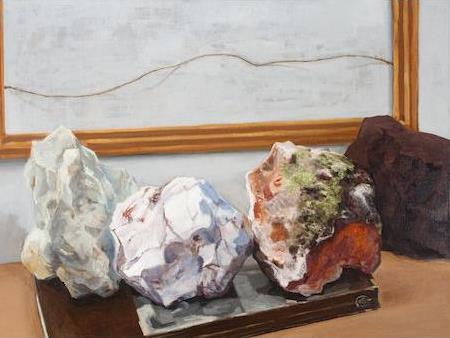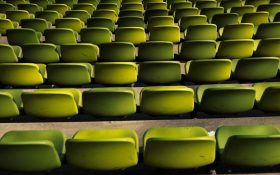Andrew Sayers, Rocks (detail).
The first time that I met artist Andrew Sayers was in our house. He came to rent a little bungalow that we had in the backyard. He wanted a quite place nearby home where he could paint and it seemed that the bungalow suited that purpose. So, in a few days Andrew was already filling the room with canvas, easels, brushes and paints.
I did not see him often; his sense of privacy was at odds with my friendly, (sometimes too friendly) Latin nature. But then one day, he left the curtains open. Led by my curiosity, I walked close to the window and I saw a self-portrait of him. In that very moment, I immediately understood the reasons for his silence: Andrew was finding himself. And his way of doing this was to look at himself so deeply in order to immortalise the features of his face and thus escape the passage of time. And what a beautiful medium to do it and what a great use of colour, I thought.
A few months passed and Andrew had changed. He was coming out of his shell and he invited me to see inside the little bungalow. The focus of his work had moved away from self-portraiture; nature and the desert were now the objects of his attention. He had recently come back from the outback and was ready to convey his memories of that experience onto the canvas. There was something curious in his paintings; they portrayed nature as though it was disappearing from the canvas, like old paintings that had slowly decayed over time. My immediate first thought was to connect his work with the Master Armando Reveron – whose genius in the technique of a fading subject matter is world-renowned. My second thought was to wonder if Andrew wanted to become invisible; that he wanted to disappear from his own reality.
Time passed by, and when I saw him again he was painting rocks. I thought: rocks – what a weird choice of subject matter! But his rocks were alive, as if they were breathing. His rocks were fragile and yet they seemed to be externally strong. In fact, Andrew’s self-portrait had simply taken another dimension: the rocks represented the dimensions of his soul, the reflection of how strong and contained he felt, yet secretly alive.
After that last encounter, he moved to a new studio and I did not hear from him for a long time. That is until one month ago, when I received an invitation to see his retrospective, a collection of 69 paintings. What an exciting rendezvous this would be!
Andrew’s recent works were just so different; nature was no longer in a faded state; it was present and established. The colours were warm; the forms were expressive. The skies were on the brink of a storm and the wind was thrashing the trees about. What a journey he had been through! What an incredible explosion of his soul and such a fantastic way to portray himself.
In this retrospective exhibition, one can really sense the passing of time. Some of the paintings are shy and discrete while others are experimentations of materiality. In some of them, the brushwork is refined and delicate while in others it is free and robust. That said, there is a strong theme throughout all of his paintings: the representations of Andrew’s life journey and the constant self-portraiture of his inner reality.
Andrew Sayers – Nature Through the Glass of Time
Lauraine Diggins Fine Art, North Caulfield
2 May – 27 June





